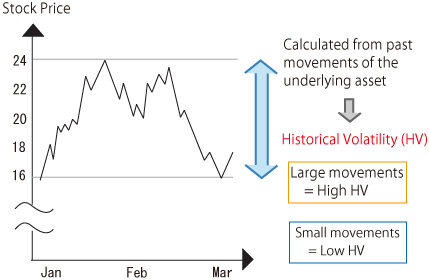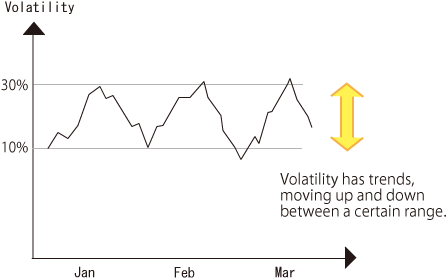9. How to take advantage of volatility

* Recap of Volatility
1. Historical Volatility (HV)

2. Implied Volatility (IV)
|
Implied Volatility |

|
|
|
Because all the factors except volatility are fixed in the market, a "measured" value of volatility can be back-calculated.
|
||
(1). How can you use volatility in a trade?

We have so far discussed the basics of volatility, but how it should be used in trading is more important for traders.

Yes, indeed. I want to know how to make money.

Alright. The values of IV and HV are shown in free softwares of brokers, so you don't need to calculate them by yourself.
When you trade options, it's wise to analyze the trend of IV.
When you trade options, it's wise to analyze the trend of IV.


So volatility has a trend, like stocks do.

That's right.
Additionally, there are following characteristics in the trend of option IV.
Additionally, there are following characteristics in the trend of option IV.
-
Each option has a certain range of IV.
(Periodic up and down in a range) - Though IV vacillates in a range most of the time, it breaks the range when the market becomes extremely volatile. (Panics and crazes)
- When IV is at low level compared with the past, there is good chance that the price of the underlying asset moves sharply in the near future.
| Option's Premium | Expected Movement of IV in the future | Advantage in trading | |
|---|---|---|---|
| Option's IV is at high level | High Price |
IV is likely to fall. | Sellers of the option have the advantage. |
| Option's IV is at low level | Low Price |
IV is likely to rise. | Buyers of the option have the advantage. |

Hmmm...
When volatility is at high level, the option's premium is high and the volatility is likely to fall in the future, and thus the premium is likely to fall.
It surely is the situation where sellers of the option have the advantage.
When volatility is at high level, the option's premium is high and the volatility is likely to fall in the future, and thus the premium is likely to fall.
It surely is the situation where sellers of the option have the advantage.

Quite conversely, when volatility is at low level, the option's premium is low and the volatility is likely to rise, and thus the premium is likely to rise, which is the situation where buyers of the option have an "edge" (trade advantage).


It should be noted that the level of "high" or "low" is quite different in different options.
Let's say there is an option whose IV is shown in the above chart. For this option, buyers have an edge when the IV is near 10%, and sellers have an edge when the IV is near 30%.
IV is directly in connection with the option's premium (price).
So traders can determine whether an option is expensive or cheap by analyzing the level of the IV.
Let's say there is an option whose IV is shown in the above chart. For this option, buyers have an edge when the IV is near 10%, and sellers have an edge when the IV is near 30%.
IV is directly in connection with the option's premium (price).
So traders can determine whether an option is expensive or cheap by analyzing the level of the IV.
In a real trade, traders should refer to IV charts (and preferably HV charts), and compare the current IV with the level in the past. Additionally, the trend of IV (either upward or downward) should be considered, too.
(2). Different Strikes (Expiration), Different Volatility

Now, let's take a look at the trading screen again.
You can see that the values of IV are different along the various strike prices.

You can see that the values of IV are different along the various strike prices.


Yes. They are all different in a range around 16 to 18 percent.

Remember that IV is affected by the market price of the option (premium) determined by traders.
Some options which many traders want to buy become expensive, while other options on the same underlying asset which many traders want to sell become cheap.
Some options which many traders want to buy become expensive, while other options on the same underlying asset which many traders want to sell become cheap.
|
Implied Volatility |

|
|
|
Option's premium is a market price determined by traders.
|
||

That leads the following conclusion:
Compare the values of IV, and you can see which option is expensive or cheap compared with other options in the same underlying asset.
Compare the values of IV, and you can see which option is expensive or cheap compared with other options in the same underlying asset.

Now I understand why IV is important.
Some options are expensive and others are cheap along different strike prices and expiration, on the same underlying asset. To judge that, I need to just check the values of IV.
Some options are expensive and others are cheap along different strike prices and expiration, on the same underlying asset. To judge that, I need to just check the values of IV.

Once in a while, IV of out-of-the-money options get much higher than that of at-the-money and in-the-money options when the price of the underlying asset moves sharply.
In such cases, you can take advantage of this "volatility skew(*)" and make a profit out of it.
In such cases, you can take advantage of this "volatility skew(*)" and make a profit out of it.
※
For example, traders buy at-the-money options and sell out-of-the-money options on the same expiration date, or buy near-month options and sell far-month options at the same strike price.
When you trade options on the same underlying asset but with different strike prices or expiration dates, you are trading a "spread" of options.
When you trade options on the same underlying asset but with different strike prices or expiration dates, you are trading a "spread" of options.

I'll check the skew of IV to make more money.
It may be fun, like finding discount clothing on sale!
It may be fun, like finding discount clothing on sale!

Yes, just like shopping.
There are many strategies in options trading, but finding the skew of volatility and taking advantage of it is the basis of all.
That's it for volatility. It wasn't that hard, was it?
Be master of volatility, and you are master of trading options.
There are many strategies in options trading, but finding the skew of volatility and taking advantage of it is the basis of all.
That's it for volatility. It wasn't that hard, was it?
Be master of volatility, and you are master of trading options.

I got it.
- 1. Advantages of Options
- 2. Basics of Options
- 3. Call Option
- 4. Put Option
- 5. Summary of Basics
- 6. Intrinsic Value and Time Value
- 7. Cover Call
- 8. What is Volatility?
- 9. How to take advantage of volatility

